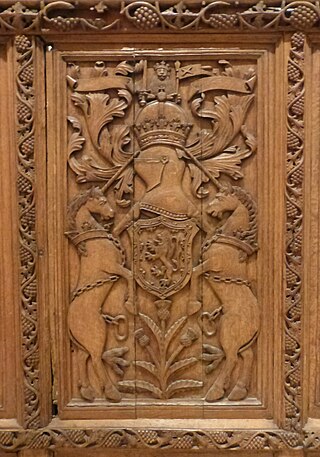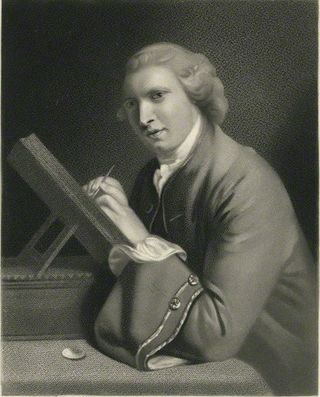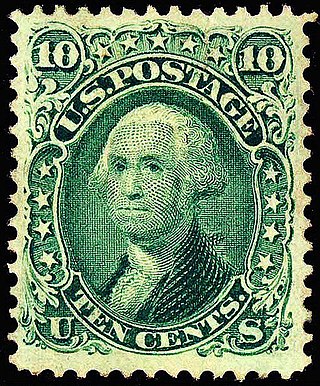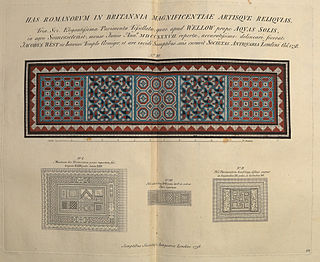
Simon Gribelin (1661–1733) was a French line engraver.

Simon Gribelin (1661–1733) was a French line engraver.
Gribelin was born at Blois in 1661, and appears to have been a son of Jacob Gribelin, an engraver, who died at Paris in 1676. After being trained in the art of engraving in Paris, he came to England about 1680. Gribelin had a son who was an engraver, and went as a draughtsman to Turkey in the service of George Hay, 8th Earl of Kinnoull.
There is a view of the Old Trinity Hospital at Deptford engraved by him in 1701. But his first work of importance was a copy of Gerard Edelinck's fine engraving of 'Alexander entering the Tent of Darius,' after Charles Le Brun, published in 1707. Soon afterwards he engraved a frontispiece and vignettes for a translation by Elizabeth Elstob of 'An English-Saxon Homily on the Birth-Day of St. Gregory' (1709), and within an initial letter he placed a neatly executed portrait of the translator. In 1712 he published six engravings from the following pictures in the royal collection at Kensington Palace: ‘Hercules between Virtue and Vice,’ after Paolo de Matteis; ‘The Adoration of the Shepherds,’ after Palma Vecchio; ‘Esther fainting before Ahasuerus,’ and ‘The Nine Muses in Olympus,’ after Tintoretto; ‘The Birth of Jupiter and Juno’ (or rather ‘The Birth of Apollo and Diana’), after Giulio Romano; and ‘The Judgment of Midas,’ after Andrea Schiavone.

In 1707 he completed a set of seven small plates of the cartoons of Raphael, with a title-page composed of a sectional view of the apartment at Hampton Court Palace in which they were then placed, and a circular portrait of Queen Anne. This series, not having been published before as a whole, met with great success. But his most important work was a large engraving on three plates, finished in 1730, of ‘The Apotheosis of James I,’ from the painting by Peter Paul Rubens on the ceiling of the banquet house at Whitehall. None of his plates, however, give any adequate idea of the style of the masters from whom they are copied, and, as George Vertue remarks, ‘at best are neat memorandums.’
He also engraved some portraits, among which are those of William III and Queen Mary, after Fowler; Prince William, Duke of Gloucester, after Sir Godfrey Kneller; Frederick Schomberg, 1st Duke of Schomberg; James Butler, 1st Duke of Ormonde, after Dahl; Sir William Dawes, archbishop of York, after Clostermann; and a small full-length of Anthony Ashley-Cooper, 3rd Earl of Shaftesbury, after the same painter, for the edition of the Characteristicks issued in 1714. There is also by him a set of thirty-seven plates of designs for goldsmith's work, as well as a large number of vignettes and head- and tail-pieces for the decoration of books. Gribelin died in Long Acre, London, on 18 January 1733, aged seventy-two, from a cold caught in going to see the king in the House of Lords. There is in the British Museum a volume of all his smaller plates, collected by himself, which was formerly in Vertue's possession.
Historian Derek Davis notes that in 1776 a committee was appointed by the Continental Congress for creating an official seal. Its members were Benjamin Franklin, Thomas Jefferson, and John Adams. While Franklin and Jefferson proposed symbolism taken from the Book of Exodus, John Adams argued for a seal based on Gribelin's engraving "The Judgement of Hercules" which was an illustration in a book in his personal library. [1] Adams' proposal did not gain support and a different design was eventually chosen.

George Vertue was an English engraver and antiquary, whose notebooks on British art of the first half of the 18th century are a valuable source for the period.

The Chandos portrait is the most famous of the portraits that are believed to depict William Shakespeare (1564–1616). Painted between 1600 and 1610, it may have served as the basis for the engraved portrait of Shakespeare used in the First Folio in 1623. It is named after the Dukes of Chandos, who formerly owned the painting. The portrait was given to the National Portrait Gallery, London on its foundation in 1856, and it is listed as the first work in its collection.

Thomas Simon, English medalist, was born, according to George Vertue, in Yorkshire about 1623.

The office of Keeper of the Privy Seal of Scotland, one of the Great Officers of State, first appears in the reign of David II. After the Act of Union 1707 its holder was normally a peer, like the Keeper of the Great Seal. The office has remained unfilled since the death of Gavin, Marquess of Breadalbane in 1922.
Events from the year 1733 in art.

Plumbago drawings are graphite drawings from the 17th and 18th centuries. There was a group of artists whose work in plumbago is remarkable for their portraits drawn with finely pointed pieces of graphite and on vellum. These works were initially prepared as the basis of an engraving. Eventually they would be produced as works in their own right.

Richard Yeo was a British medalist and Chief Engraver at the Royal Mint, in which capacity he supplied patterns for the guinea and five guinea coins of George III. He was a founding member of the Royal Academy of Art, and appears in the group portrait by John Zoffany.

Presidents of the United States have frequently appeared on U.S. postage stamps since the mid-19th century. The United States Post Office Department released its first two postage stamps in 1847, featuring George Washington on one, and Benjamin Franklin on the other. The advent of presidents on postage stamps has been definitive to U.S. postage stamp design since the first issues were released and set the precedent that U.S. stamp designs would follow for many generations.

Vetusta Monumenta is the title of a published series of illustrated antiquarian papers on ancient buildings, sites and artefacts, mostly those of Britain, published at irregular intervals between 1718 and 1906 by the Society of Antiquaries of London. The folio-sized papers, usually written by members of the society, were first published individually, and then later in collected volumes.

The Regular Issues of 1922–1931 were a series of 27 U.S. postage stamps issued for general everyday use by the U.S. Post Office. Unlike the definitives previously in use, which presented only a Washington or Franklin image, each of these definitive stamps depicted a different president or other subject, with Washington and Franklin each confined to a single denomination. The series not only restored the historical tradition of honoring multiple presidents on U.S. Postage but extended it. Offering the customary presidential portraits of the martyred Lincoln and Garfield, the war hero Grant, and the founding fathers Washington and Jefferson, the series also memorialized some of the more recently deceased presidents, beginning with Hayes, McKinley, Cleveland and Roosevelt. Later, the deaths of Harding, Wilson and Taft all prompted additions to the presidential roster of Regular Issue stamps, and Benjamin Harrison's demise (1901) was belatedly deemed recent enough to be acknowledged as well, even though it had already been recognized in the Series of 1902. The Regular Issues also included other notable Americans, such as Martha Washington and Nathan Hale—and, moreover, was the first definitive series since 1869 to offer iconic American pictorial images: these included the Statue of Liberty, the Capitol Building and others. The first time (1869) that images other than portraits of statesmen had been featured on U.S. postage, the general public disapproved, complaining that the scenes were no substitute for images of presidents and Franklin. However, with the release of these 1922 regular issues, the various scenes—which included the Statue of Liberty, the Lincoln Memorial and even an engraving of an American Buffalo—prompted no objections. To be sure, this series presented pictorial images only on the higher-value stamps; the more commonly used denominations, of 12 cents and lower, still offered the traditional portraits.

John Pine (1690–1756) was an English designer, engraver, and cartographer notable for his artistic contribution to the Augustan style and Newtonian scientific paradigm that flourished during the British Enlightenment.
Simon Du Bois or Dubois ), was a portrait painter, of Flemish or Dutch origin, active in England from 1685 until his death.
Louis Du Guernier (1677–1716), also anglicized as Lewis Du Guernier, was a Franco-English engraver.
Gaspard Duchange (1662–1757) was a French engraver.
John Payne (1607–1647) was an English engraver, who was one of the earliest exponents of the art of engraving in England. His best work was the finest produced by a native-born engraver working during the reign of Charles I.
Jean Simon, anglicized as John Simon was an English mezzotint engraver and print publisher of French Huguenot birth, particularly known for his portraits. Notably associated with the German-born portrait painter Godfrey Kneller, Simon had an active career that spanned at least three and a half decades, and was regarded as one of the mezzotint medium's most prolific masters of his generation, along with the older contemporaneous engraver John Smith.
Andrew Miller was an English mezzotint engraver.

Johann Lorenz Natter (1705–1763) was a German gem-engraver and medallist.
In early 18th century Colonial America, engravers began experimenting with copper plates as an alternative medium to wood. Applied to the production of paper currency, copper-plate engraving allowed for greater detail and production during printing. It was the transition to steel engraving that enabled banknote design and printing to rapidly advance in the United States during the 19th century.
![]() This article incorporates text from a publication now in the public domain : "Gribelin, Simon". Dictionary of National Biography . London: Smith, Elder & Co. 1885–1900.
This article incorporates text from a publication now in the public domain : "Gribelin, Simon". Dictionary of National Biography . London: Smith, Elder & Co. 1885–1900.